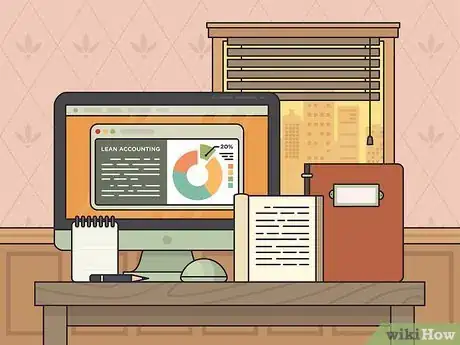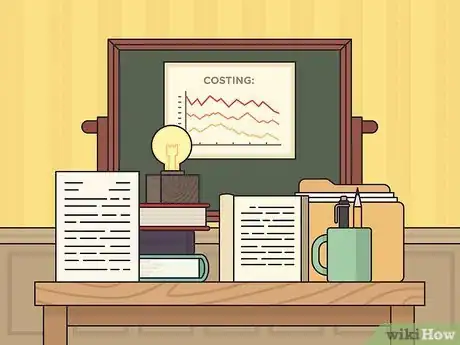This article was co-authored by John Gillingham, CPA, MA. John Gillingham is a Certified Public Accountant, the Owner of Gillingham CPA, PC, and the Founder of Accounting Play, Apps to teach Business & Accounting. John, who is based in San Francisco, California, has over 14 years of accounting experience and specializes in assisting consultants, bootstrapped startups, pre-series A ventures, and stock option compensated employees. He received his MA in Accountancy from the California State University - Sacramento in 2011.
There are 18 references cited in this article, which can be found at the bottom of the page.
This article has been viewed 9,451 times.
Cost accounting is a branch of accounting that’s centered around identifying, recording, and analyzing a business’s expenses. The reports generated by cost accountants help managers and business directors to make decisions that minimize unnecessary operating costs.[1] While it can be helpful to take a course or two, you don’t need a formal education to gain a working understanding of cost accounting. All you need is a willingness to learn and a good grasp of key financial management concepts.
Steps
Getting a Formal Education
-
1Focus on math if you’re currently in school. Cost accounting is all about juggling numbers. For this reason, it will benefit you to become proficient in elementary and intermediate mathematical operations. In particular, you should be able to add, subtract, multiply, and divide large sums with and without the aid of a calculator.[2]
- If you’re a college student, consider enrolling in one or more fundamental math courses, such as algebra, probability/statistics, applied mathematics, or data analysis. These skills you’ll pick up in the courses will prepare you for the kinds of tasks and problems you’ll encounter as a cost accountant.[3]
-
2Earn a degree in cost accounting. These days, most universities and community colleges offer whole courses in cost accounting. Take some time to compare various schools with well-reviewed accounting programs in your neck of the woods. Narrow down your search to accredited institutions to make sure you’re getting the best education you can.[4]
- You also have the option of signing up for select courses if you just want to learn the basics of cost accounting in order to excel in your current position.
- Cost accounting and related subjects typically make up one or two semesters’ worth of the curriculum for an undergraduate accounting program.
Tip: If you plan on starting a career in cost accounting, keep in mind that most employers will expect you to hold a minimum of a bachelor’s degree.[5]
Advertisement -
3Pursue your master’s degree to unlock higher positions within the field. If you think you might want to make cost accounting your career, having an advanced degree under your belt will put you in the running for coveted promotions and employment opportunities later on down the line. More specifically, you’ll want to go for a Master’s of Business Administration (MBA) with a focus on accounting.[6]
- Most MBA programs take an average of 2 years to complete.
- In some cases, you may be able to get your MBA from the same school that awarded you your bachelor’s degree.
-
4Take a cost accounting course online. Run a quick search for “online cost accounting course” to pull up a list of potential options. Before you sign up, check to make sure that the course you’re looking at is offered by either an accredited institution or a reputable third-party company. One of these courses will expose you to the same sorts of principles and procedures that you would learn in an academic setting.[7]
- Many of these pay-by-lesson courses are relatively inexpensive, while some open-source resources may even be completely free.[8]
- Web-based courses can serve as a convenient, low-cost alternative to traditional instruction if you don’t have the time or budget to go to college.
Understanding the Different Types of Cost Accounting
-
1Familiarize yourself with standard cost accounting.[9] Standard cost accounting (or “costing,” as it’s more commonly known) is a universal cost accounting system used by almost all businesses. Its primary function is to identify the difference between the actual costs of producing goods or services and how much it should cost to produce those same goods and services.[10]
- Accounting textbooks can provide valuable insight into the practices and theories that characterize standard costing.[11]
- Standard cost accounting takes it name from the term “standard cost,” which refers to the amount of money that a business estimates that it should cost to produce a good or service.
Tip: Standard cost accounting is arguably the most important costing system to learn, as it’s the most widely-employed and serves as the basis for other, more complex systems.
-
2Delve into the specifics of activity-based cost accounting.[12] Unlike standard cost accounting, which only compares a couple of big factors, activity-based costing takes a multi-pronged approach to controlling costs. Implementing an activity-based analysis involves lots of closely-linked steps, which include identifying costs, loading cost pools, measuring activity drivers, and allocating costs by priority.[13]
- The best way to wrap your brain around activity-based cost accounting is to study models and examples that use real-world scenarios to illustrate the many interrelated steps. You'll find models like this in accounting textbooks, as well as online on various websites and blogs.[14]
- Activity-based costing is most often carried out by a professional accountant, who is responsible for knowing the financial ins and outs of each separate office or department within the company.[15]
- Because of its exhaustive, close-up look at a business’s operations, activity-based costing allows the accountant to make much more accurate and reliable calculations.
-
3Read up on marginal costing. Marginal costing deals with sets of procedures required to determine a business’s optimum production quantity or rate. Once the company’s managers or directors know exactly how much money it will take to produce additional units, they can rescale operations as needed to ramp up production at the lowest possible cost.[16]
- Along with the usual accounting resources, breaking down the operations of major manufacturers can give you a better idea of the ins-and-outs of marginal costing.[17]
- Marginal costing tend to be of vital importance to businesses that produce goods in bulk, since every penny counts.
-
4Learn a little bit about lean accounting. Lean accounting is a little different from other systems of accounting, as it has to with inventory rather than production or efficiency. It’s main purpose is to reduce waste by investigating factors like production capacity, scrap rate, holding and storage practices, lead time, and turnover rates. This kind of reporting helps businesses confirm that they’re not making more than they can sell.[18]
- Many companies and accounting schools publish "best practices" guides for lean accounting that outline the methods that work best under a range of possible circumstances.[19]
- When conducted correctly, lean accounting can ensure a better value for the consumer and cut down on the amount of work that goes into routine cost analysis.
Developing Key Accounting Skills
-
1Become a master of Excel. Microsoft’s advanced spreadsheet platform is one of the most-used tools in a cost accountant’s arsenal. Though its layout isn’t exactly intuitive, it is powerful, making it possible to do things like process ledger entries, create cost element dimensions, calculate overhead, and define new cost-control parameters with a few keystrokes.[20]
- Excel’s layout make it ideal for both organizing and presenting large quantities of data. As such, it’s often used as the basis for in-house financial reports.[21]
Tip: If you need some help learning the ropes, browse the Internet for instructional articles, or pull up some video tutorials on YouTube.
-
2Create a personal budget for yourself. If you don’t do so already, start tracking your own income and expenses to practice what you’ve learned. Write down every transaction in a notebook or spreadsheet, along with detailed notes about where your money is going.[22] Review your records regularly to set safe spending limits, generate savings, and look for ways to cut unnecessary costs.[23]
- Apps like Personal Capital, Mint, and PocketGuard can make it easier to keep up with your financial information over time.[24]
- Balancing a personal or household budget is quite similar to performing cost analysis for a business, and can be a great way to rack up some firsthand experience following the flow of money.
-
3Be able to analyze and interpret complex financial data. Whether you’re seeking a position as a cost accountant or just want to make yourself more of an asset at your current job, understanding the information you’re presented is paramount. You must be able to not only make sense of the relationships between individual figures, but also to explain them to your employer in a way that enables them to make practical decisions.[25]
- Keeping up with a business’s operating costs isn’t always as straightforward as weighing expenses against revenue. Cost factors are many and varied, and must often be pieced together like a puzzle to paint a clear picture of how the money is moving.
- Strong communication skills are a must if you hope to one day work for a major company. To some degree, the business’s profit potential will be riding on how well you can break down the numbers.[26]
References
- ↑ John Gillingham, CPA, MA. Certified Public Accountant. Expert Interview. 3 March 2020.
- ↑ https://www.jobhero.com/how-to-become-cost-accountant/
- ↑ https://www.wallstreetoasis.com/blog/do-i-need-math-for-finance
- ↑ https://www.accountingedu.org/cost-accounting.html
- ↑ https://www.jobhero.com/how-to-become-cost-accountant/
- ↑ https://www.jobhero.com/how-to-become-cost-accountant/
- ↑ https://digitaldefynd.com/best-accounting-courses/
- ↑ https://www.arbitrue.com/blog/9-free-online-accounting-courses-you-can-start-right-now/
- ↑ John Gillingham, CPA, MA. Certified Public Accountant. Expert Interview. 3 March 2020.
- ↑ https://efinancemanagement.com/costing-terms/types-of-cost-accounting
- ↑ https://www.blog.consultants500.com/accounting-audit-advisory/top-15-accounting-books-recommended-most-times-by-business-owners-students-or-accounting-pros/
- ↑ John Gillingham, CPA, MA. Certified Public Accountant. Expert Interview. 3 March 2020.
- ↑ https://www.accountingtools.com/articles/2017/5/14/activity-based-costing
- ↑ https://www.business-case-analysis.com/activity-based-costing.html
- ↑ https://www.jobhero.com/how-to-become-cost-accountant/
- ↑ https://www.accountingcoach.com/blog/what-is-marginal-cost
- ↑ http://www.economicsdiscussion.net/cost-accounting/applications-of-marginal-costing/31695
- ↑ https://www.journalofaccountancy.com/issues/2004/jul/thelowdownonleanaccounting.html
- ↑ https://trace.tennessee.edu/cgi/viewcontent.cgi?article=2187&context=utk_chanhonoproj
- ↑ https://www.wallstreetoasis.com/blog/do-i-need-math-for-finance
- ↑ https://www.cost-accounting-info.com/excel-spreadsheet-formulas.html
- ↑ John Gillingham, CPA, MA. Certified Public Accountant. Expert Interview. 3 March 2020.
- ↑ https://www.bankrate.com/financing/saving-money/5-steps-to-balancing-your-budget/
- ↑ https://www.cnet.com/news/the-best-budgeting-apps/
- ↑ https://www.businessstudent.com/careers/cost-accountant/
- ↑ https://www.jobhero.com/how-to-become-cost-accountant/

















-Step-9.webp)













































